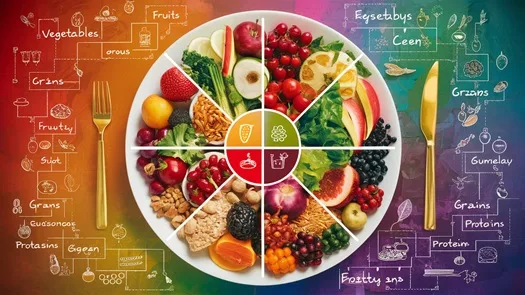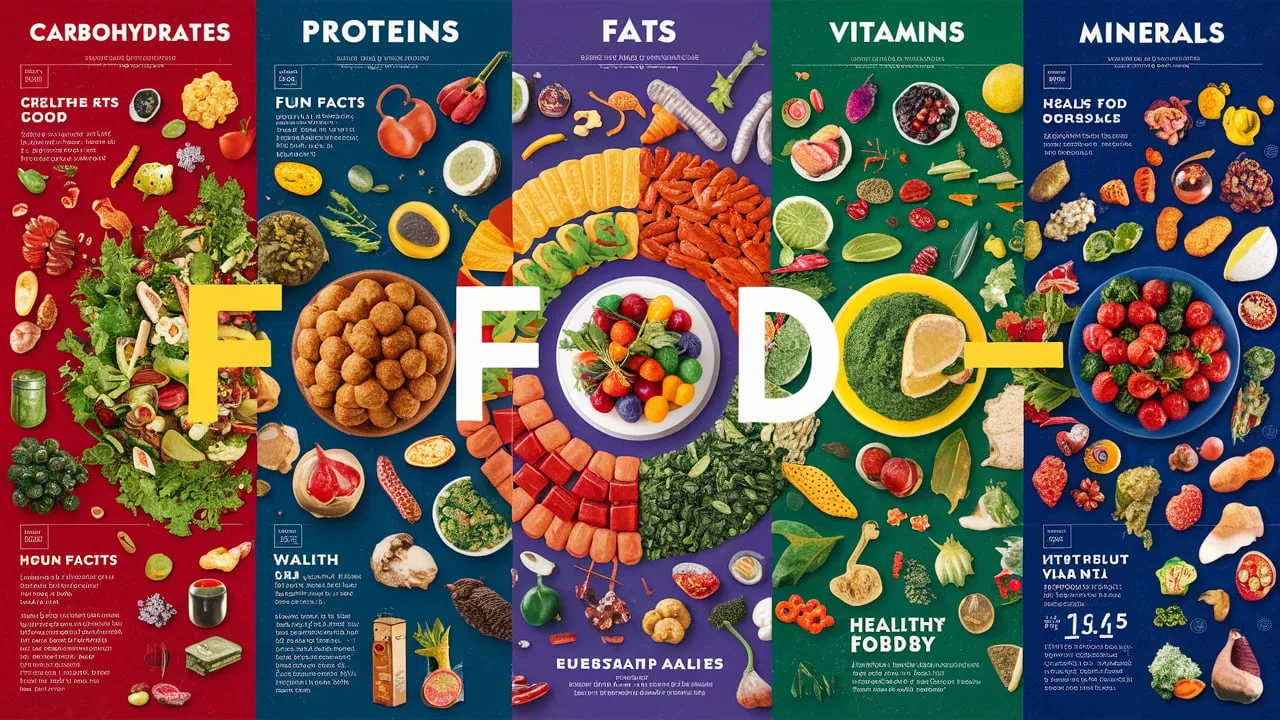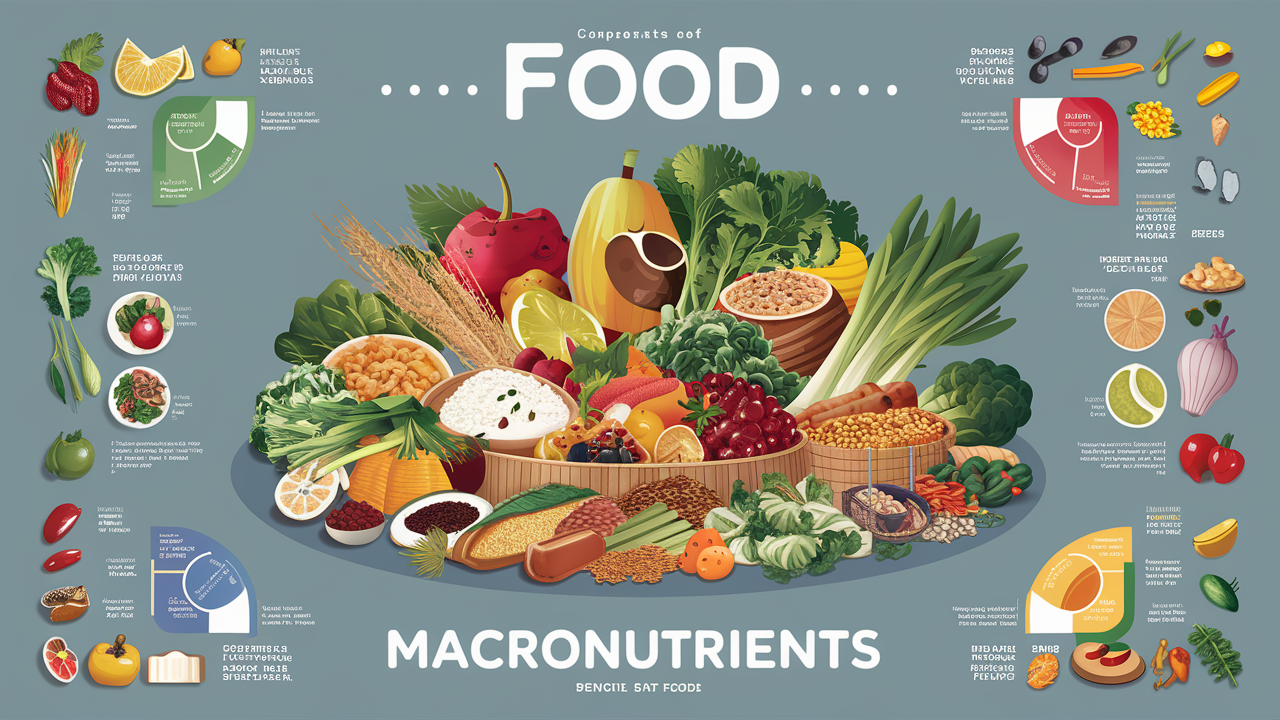
Class 6 Science Chapter 1 – Components of Food
What are the main components of food ?

Components of Food is a foundational educational resource designed for sixth-grade students, focusing on the essential nutrients that constitute food and their roles in human health. This chapter emphasizes the importance of both macronutrients—carbohydrates, proteins, and fats—and micronutrients—vitamins and minerals—illustrating how they contribute to growth, energy production, and overall well-being. Understanding these components is vital for fostering healthy eating habits from a young age, which can significantly impact long-term health outcomes. The chapter is notable for its comprehensive approach to nutrition education, highlighting not only the biological significance of these nutrients but also the practical aspects of incorporating them into a balanced diet. It addresses common misconceptions about dietary needs, such as the necessity of hydration and the importance of dietary fiber, thus providing students with a holistic view of nutrition. Additionally, it emphasizes the role of water as a crucial nutrient, despite not providing calories, and discusses the benefits of cooking methods in preserving nutrient content. Prominent controversies surrounding dietary guidelines and nutrient recommendations are briefly touched upon, such as the debates over the consumption of fats and sugars, the role of ultra-processed foods, and varying perspectives on optimal dietary patterns. These discussions are framed within the context of promoting critical thinking among students regarding food choices and dietary practices, making the chapter not just an academic exercise, but a practical guide for healthy living. In summary, Chapter 2 of Class 6 Science serves as an essential tool for students to grasp the foundational principles of nutrition, advocating for a balanced diet that encompasses a variety of food groups while addressing contemporary dietary issues. Its incorporation of teaching strategies further enhances its effectiveness in promoting lasting healthy habits among young learners.
Macronutrients
Macronutrients are essential nutrients required by the body in large amounts to maintain health and support various physiological functions. The three primary classes of macronutrients are carbohydrates, proteins, and lipids (fats). These macronutrients are metabolically processed to generate energy, serving as the primary building blocks of the diet.
Carbohydrates
Carbohydrates are organic molecules composed of carbon, hydrogen, and oxygen, and they are a major source of energy for the body. They can be classified into two main types: simple carbohydrates and complex carbohydrates. Simple carbohydrates, or simple sugars, consist of one or two sugar units, such as glucose and sucrose, and are typically found in fruits, milk, and table sugar. Complex carbohydrates, on the other hand, consist of longer chains of sugar units and include starches and fibers, which are found in grains, vegetables, and legumes. The body converts carbohydrates into glucose, which can be used for immediate energy or stored as glycogen for future use. One gram of carbohydrates yields approximately four kilocalories of energy. Carbohydrates are not only essential for energy but also play a crucial role in the proper functioning of the nervous system, heart, and kidneys.
Proteins
Proteins are composed of chains of amino acids and are vital for growth, repair, and maintenance of tissues. They provide structure to cells and play significant roles in various biochemical reactions. Proteins are often referred to as the “workhorses” of life, as they are involved in nearly every cellular process. Sources of protein include meats, dairy products, seafood, and plant-based foods, particularly legumes and nuts. Each gram of protein provides about four kilocalories of energy.
Lipids
Lipids, commonly known as fats, are another category of macronutrients that provide energy and support various bodily functions. They are crucial for the absorption of fat-soluble vitamins, cellular structure, and hormone production. While fats are high in calories, they are an important energy source, especially during prolonged physical activity or periods of fasting. Healthy sources of fats include nuts, seeds, fish, and vegetable oils, while saturated and trans fats should be limited due to their association with adverse health effects.
Micronutrients
Micronutrients are essential nutrients that the body requires in smaller amounts to support various bodily functions, despite not providing energy directly like macronutrients do. They encompass both vitamins and minerals, with a total of sixteen essential minerals and thirteen vitamins recognized for their crucial roles in maintaining health and well-being.
Vitamins
Vitamins are classified into two groups based on their solubility:
- Water-soluble Vitamins: This group includes vitamin C and the B vitamins (thiamine, riboflavin, niacin, pantothenic acid, pyridoxine, biotin, folate, and cobalamin). Water-soluble vitamins must be consumed regularly, as they are not stored in the body and excess amounts are excreted in urine.
- Fat-soluble Vitamins: Comprising vitamins A, D, E, and K, these vitamins can be stored in the body’s fatty tissues and liver. They are utilized by the body as needed, aiding functions such as vision, immune response, and bone health. Vitamins are crucial for various bodily functions, including red blood cell production, synthesis of bone tissue, and maintaining a healthy nervous system. Deficiencies in essential vitamins can lead to significant health issues, such as anemia, weakened immunity, and various metabolic disorders.
Minerals
Minerals are inorganic substances that exist in solid crystalline forms and are classified based on the amounts required by the body.
- Macrominerals: These are required in larger amounts, typically in hundreds of milligrams, and include calcium, magnesium, potassium, sodium, and phosphorus. Macrominerals are vital for numerous physiological functions such as bone formation, fluid balance, and muscle contraction.
- Trace Minerals: Required in much smaller amounts (milligrams or less), trace minerals include iron, zinc, selenium, molybdenum, and iodine. They play essential roles in enzyme function, hormone synthesis, and protecting against oxidative stress.
Importance of Micronutrients
Micronutrients play integral roles in enhancing bodily functions, supporting growth, and preventing diseases. They assist in energy metabolism, nerve function, and maintaining skin health, among other functions. A well-balanced diet rich in fruits, vegetables, whole grains, and lean proteins usually provides sufficient micronutrients for healthy individuals. However, those with dietary restrictions or specific health conditions may require supplementation to prevent deficiencies.
Water
Water is an essential nutrient that plays a critical role in maintaining health and supporting life. It is the most important nutrient for humans, as the body is composed of over 60 percent water. Unlike other macronutrients, water does not provide calories, but it is required in large quantities for various vital functions, including digestion, absorption, circulation, and regulation of body temperature.
Daily Water Requirements
Current guidelines recommend that adult females consume approximately 2.0 liters (around 8.5 cups) of water per day, while adult males should aim for about 2.5 liters (approximately 10.5 cups) per day. These values account for both direct water intake and the water content in food, with about 80 percent of daily water intake typically coming from beverages and 20 percent from food sources. Historically, the recommendation of six to eight glasses of water daily lacks a scientific foundation. The Food and Nutrition Board of the National Research Council initially suggested an intake of 1 milliliter of water for every calorie consumed, indicating that most of this water is obtained from prepared foods.
Importance of Water
Water is vital for numerous bodily processes, such as flushing out toxins, shock absorption, transporting nutrients, preventing constipation, and providing lubrication and hydration. Every cell in the human body relies on water to function properly, and without sufficient water intake, even slight dehydration can lead to headaches and impaired physical and mental functioning.
Sources of Water
Natural, unsweetened water is the best source of hydration. For those who find plain water unpalatable, adding a squeeze of lemon or consuming fruits and vegetables with high water content can be effective alternatives. Maintaining proper hydration is essential for overall health and wellness, making water an indispensable component of the diet.
Dietary Fiber
Dietary fiber is a type of carbohydrate that is essential for maintaining health and aiding digestion. Unlike other carbohydrates, dietary fiber is not completely digested by the human body, and it plays a crucial role in stabilizing blood sugar levels and promoting gut health.
Types of Dietary Fiber
Dietary fiber is generally categorized into two main types: soluble and insoluble fiber.
Soluble Fiber
Soluble fiber dissolves in water to form a gel-like substance. It can be found in foods such as oats, barley, legumes, and certain fruits, including citrus fruits and apples. This type of fiber can help lower blood cholesterol levels and improve blood sugar control by slowing down the absorption of sugar in the digestive tract.
Insoluble Fiber
Insoluble fiber, on the other hand, does not dissolve in water and adds bulk to the digestive contents, which helps with regular bowel movements. It is found in foods like whole grains and wheat bran. While it does not directly lower cholesterol, it contributes to digestive health by facilitating peristalsis, the rhythmic contractions of the intestines that move food through the digestive system.
Health Benefits
The consumption of adequate dietary fiber is linked to numerous health benefits. It aids in digestion, prevents constipation, and can lower the risk of various chronic diseases such as heart disease, diabetes, and certain types of cancer. The Academy of Nutrition and Dietetics recommends that women aim for 25 grams of fiber per day and men aim for 38 grams. Moreover, dietary fiber can also act as food for the gut microbiome, producing beneficial short-chain fatty acids and other metabolites that support overall health. However, many individuals struggle to meet their fiber intake needs, making fiber supplements popular, although these should not replace fiber-rich foods.
Cooking and Preparation
Cooking is an essential process that not only enhances the flavor of food but also plays a crucial role in its nutritional value. While the act of cooking can alter certain nutrients, it also offers various benefits, such as improved digestibility and enhanced safety through the destruction of harmful microorganisms.
Benefits of Cooking
Cooking food can have several advantages, including:
- Improving Flavor and Texture: Cooking methods such as grilling and roasting can create caramelized flavors through the Maillard reaction, enhancing the overall taste of meals.
- Digestibility: Cooking can break down complex parts of food, making it easier for the body to digest. For example, cooking legumes increases their digestibility and reduces anti-nutritional factors.
- Nutrient Availability: Some nutrients, such as phytochemicals in tomatoes, become more bioavailable when cooked.
Nutritional Impact of Cooking Methods
Different cooking techniques can significantly impact the nutrient content of foods.
Boiling and Simmering
These methods involve cooking food in water at varying temperatures. Although effective for cooking, boiling can lead to significant losses of water-soluble vitamins, such as vitamin C and the B vitamins.
Steaming
Steaming is a cooking method that retains more nutrients compared to boiling, especially if flavorings like herbs are added to the cooking water. This method preserves the natural texture and taste of vegetables while minimizing nutrient loss.
Baking
While baking can help retain protein and other nutrients in meats, it may damage certain vitamins, including vitamin C and B-complex vitamins. The nutritional quality largely depends on the ingredients used.
Grilling and Broiling
Both methods utilize dry heat and can enhance flavor through the Maillard reaction. However, some sensitive vitamins may be lost during this process.
Microwave Cooking
This technique is known for its ability to cook food quickly, which can help retain more nutrients compared to longer cooking methods.
Ultra-Processed Foods
In contrast to minimally processed and fresh foods, ultra-processed foods often contain additives, such as artificial colors and flavors, that can detract from their nutritional value. These foods, which include sugary beverages and packaged snacks, are generally high in added sugars, salt, and unhealthy fats, leading to health concerns when consumed excessively.
Balanced Diet
A balanced diet is essential for maintaining good health and proper functioning of the body. It encompasses a variety of food items that provide different types of nutrients in adequate amounts, including proteins, carbohydrates, fats, vitamins, and minerals. This diet should also ensure a sufficient intake of dietary fiber and water to support overall health.
Core Elements of a Balanced Diet
A balanced diet typically includes foods from the following core elements:
- Proteins: Sources include pulses, meat, fish, and dairy products, which are vital for growth and repair of body tissues.
- Fruits and Vegetables: These provide essential vitamins, minerals, and dietary fiber, which aid in digestion and overall health.
- Grains: Foods like rice, wheat, and whole grains offer carbohydrates, which are necessary for energy.
- Fats/Oils: While fats are essential for various bodily functions, they should be consumed in moderation to prevent excessive weight gain.
- Dairy: Low-fat or fat-free dairy products contribute to calcium intake, crucial for bone health.
Importance of a Balanced Diet
A balanced diet plays a significant role in maintaining good health throughout life and reduces the risk of developing chronic health conditions, such as heart disease, diabetes, and obesity. Poor dietary habits can lead to various health issues, including fatigue, brain fog, and a higher susceptibility to infections.
Nutritional Guidelines
To achieve a balanced diet, individuals are encouraged to:
- Focus on portion control to avoid overeating, as larger portion sizes can lead to increased calorie consumption.
- Include a variety of foods from all food groups to ensure the intake of necessary nutrients in the right proportions.
- Be mindful of cooking methods, as excessive washing or improper cooking can lead to nutrient loss.
Special Considerations
Children and adolescents require special attention regarding their diet to support their growth and development. The Dietary Guidelines for Americans recommend a healthy eating pattern that includes a variety of fruits and vegetables, whole grains, and lean protein sources. Following these guidelines can help prevent health issues and promote overall well-being.
Teaching Strategies
Various teaching strategies have been identified as effective for promoting nutritional knowledge and healthy eating habits among primary school students. A synthesis of 49 studies highlighted eight dominant teaching strategies tailored to address areas such as food consumption, fruit and vegetable preference, and nutritional knowledge.
Enhanced Curriculum Approaches
Enhanced curriculum approaches involve specialized nutrition education programs that extend beyond the existing health curricula. These programs are delivered by teachers or specialists, with 29 studies reporting their use as effective interventions to improve dietary habits among students.
Cross-Curricular Approaches
Cross-curricular approaches integrate nutrition education across multiple traditional subjects, enabling a more holistic understanding of healthy eating. This strategy was noted in 11 studies, emphasizing the importance of context in learning.
Parental Involvement
Parental involvement in nutrition education programs encourages active participation from guardians, either within or outside the school environment. This strategy was utilized in 10 studies and has shown to facilitate communication between children and their parents, enhancing the learning experience.
Experiential Learning Approaches
Experiential learning approaches emphasize hands-on experiences, allowing students to engage actively with nutritional concepts. These strategies often include activities such as cooking and gardening, which can reinforce the importance of healthy food choices.
Importance of Early Interventions
Research indicates that implementing nutrition education interventions during early childhood can leverage children’s innate learning abilities, promoting lasting healthy behaviors into adulthood. Schools play a crucial role in this process, as they provide structured environments conducive to learning about healthy dietary habits.
Multicomponent Strategies
Successful interventions often adopt a multicomponent approach, combining various strategies to engage students and their families effectively. Such programs ensure fidelity to the intended outcomes, providing age-appropriate activities that are sustained over a significant duration. By integrating these diverse teaching strategies into the classroom, educators can significantly enhance students’ understanding of nutrition and encourage the adoption of healthier eating habits.
Evidence and Research
Overview of Studies
A systematic review and meta-analysis of cross-sectional studies examined the relationship between dietary diversity and the risk of wasting, stunting, and thinness among school-aged children. This review was initiated due to the lack of previous studies addressing this specific connection. The search for relevant literature involved retrieving over 200,000 potential citations, which were refined to 487 publications considered for review based on specific criteria, including publication date and availability of full texts.
Nutrition Education Programs
A study conducted in Japan implemented a school-based nutrition education program that involved both children and their guardians. The program aimed to enhance nutrition knowledge and improve dietary habits among students through lectures, homework, and teaching materials. Evaluation of the program indicated significant improvements in children’s nutrition knowledge and attitudes towards healthy eating. It highlighted the importance of integrating parental involvement in dietary education to address nutritional disparities.
Impact of Nutrition Education
Research has shown that well-structured nutrition education can positively influence dietary behaviours in children. Studies suggest that when qualified teachers conduct these programs, they can effectively enhance students’ understanding of nutritional concepts, as evidenced by improved consumption of fruits and vegetables and better knowledge of major nutrients. However, it is noted that U.S. students receive insufficient nutrition education—less than 8 hours annually, far below the recommended 40 to 50 hours needed for significant behavioural changes.
Global Insights
The review of literature spanning seven global regions revealed persistent issues of stunting and thinness among children, particularly in affluent and urban households. This underscores the necessity for comprehensive dietary interventions that target not only individual behaviours but also broader societal factors, including agricultural practices and public health policies. The study reinforces that nutrition education is essential for empowering children to make informed dietary choices and ultimately improve their health outcomes.

Exercise Questions of Components of Food
1. Name the major nutrients in our food.
Solution:
The major nutrients in our food are Carbohydrates, Proteins, Lipids, Vitamins, Minerals and dietary fibres.
2. Name the following:
(a) The nutrients which mainly give energy to our body.
(b) The nutrients that are needed for the growth and maintenance of our body.
(c) A vitamin required for maintaining good eyesight.
(d) A mineral that is required for keeping our bones healthy.
Solution:
- a) Carbohydrates
- b) Proteins and minerals
- c) Vitamin A
- d) Calcium
3. Name two foods, each rich in:
(a) Fats
(b) Starch
(c) Dietary fibre
(d) Protein
Solution:
a) Cream, butter
b) Rice, wheat
c) Whole grains, raw vegetables
d) Milk, soya bean
4. Tick (√) the statements that are correct.
(a) By eating rice alone, we can fulfil the nutritional requirements of our body. ( )
(b) Deficiency diseases can be prevented by eating a balanced diet. ( )
(c) Balanced diet for the body should contain a variety of food items. ( )
(d) Meat alone is sufficient to provide all nutrients to the body. ( )
Solution:
(a) By eating rice alone, we can fulfil the nutritional requirements of our body. ( )
(b) Deficiency diseases can be prevented by eating a balanced diet. (√ )
(c) Balanced diet for the body should contain a variety of food items. (√ )
(d) Meat alone is sufficient to provide all nutrients to the body. ( )
5. Fill in the blanks.
(a) ______________ is caused by the deficiency of Vitamin D.
(b) Deficiency of ______________ causes a disease known as beriberi.
(c) Deficiency of Vitamin C causes a disease known as ______________.
(d) Night blindness is caused due to deficiency of ____________ in our food.
Solution:
(a) Rickets is caused by the deficiency of Vitamin D.
(b) Deficiency of Vitamin B1 causes a disease known as beriberi.
(c) Deficiency of Vitamin C causes a disease known as Scurvy.
(d) Night blindness is caused due to deficiency of Vitamin A in our food.

Chapter 2: Components of Food – FAQ
Q1: What are the main components of food?
A: The main components of food are carbohydrates, proteins, fats, vitamins, minerals, water, and dietary fibers. Each component plays a crucial role in maintaining the body’s health.
Q2: What is the role of carbohydrates in our diet?
A: Carbohydrates provide energy to the body. They are the primary source of fuel for all physical activities and metabolic processes. Foods like rice, bread, and potatoes are rich in carbohydrates.
Q3: Why are proteins important for the body?
A: Proteins are essential for growth, repair of body tissues, and building muscles. They are also involved in the formation of enzymes and hormones. Foods like eggs, fish, beans, and nuts are rich in proteins.
Q4: What are the functions of fats?
A: Fats provide energy, help absorb certain vitamins (like A, D, E, and K), and protect vital organs. They are also important for maintaining healthy skin and hair. Sources of fats include butter, oil, and ghee.
Q5: What is the importance of vitamins and minerals?
A: Vitamins and minerals are essential for various bodily functions. Vitamins help in regulating metabolism, boosting immunity, and supporting growth. Minerals are important for bone health, nerve function, and blood circulation. Examples include Vitamin C for immunity and calcium for strong bones.
Q6: What is dietary fiber, and why is it important?
A: Dietary fiber helps in digestion by preventing constipation. It is not digested by the body but helps in maintaining bowel health. Foods like fruits, vegetables, and whole grains are rich in fiber.
Q7: Why is water considered a vital component of food?
A: Water is essential for all body functions, including digestion, absorption, circulation, and regulation of body temperature. It also helps transport nutrients and removes waste from the body.
Q8: What are deficiency diseases?
A: Deficiency diseases occur when the body lacks certain nutrients over a period of time. For example, a lack of Vitamin C causes scurvy, and a deficiency of iron leads to anemia.
Q9: How do we test for the presence of starch in food?
A: To test for starch, add a few drops of iodine solution to the food. If the food contains starch, it will turn blue-black.
Q10: What are the symptoms of protein deficiency?
A: Protein deficiency can lead to diseases like kwashiorkor and marasmus. Symptoms include swelling in parts of the body, muscle loss, fatigue, and delayed growth in children.
Q11: What is the difference between fats and oils?
A: Fats are usually solid at room temperature, while oils are liquid. Both are types of fats, but their structure and sources vary. For example, butter is a solid fat, while olive oil is a liquid fat.
Q12: Why do we need a balanced diet?
A: A balanced diet ensures that the body gets all the essential nutrients in the right proportions for proper growth, development, and functioning. It includes the right amounts of carbohydrates, proteins, fats, vitamins, minerals, and water.
Also Visit: Readspot



